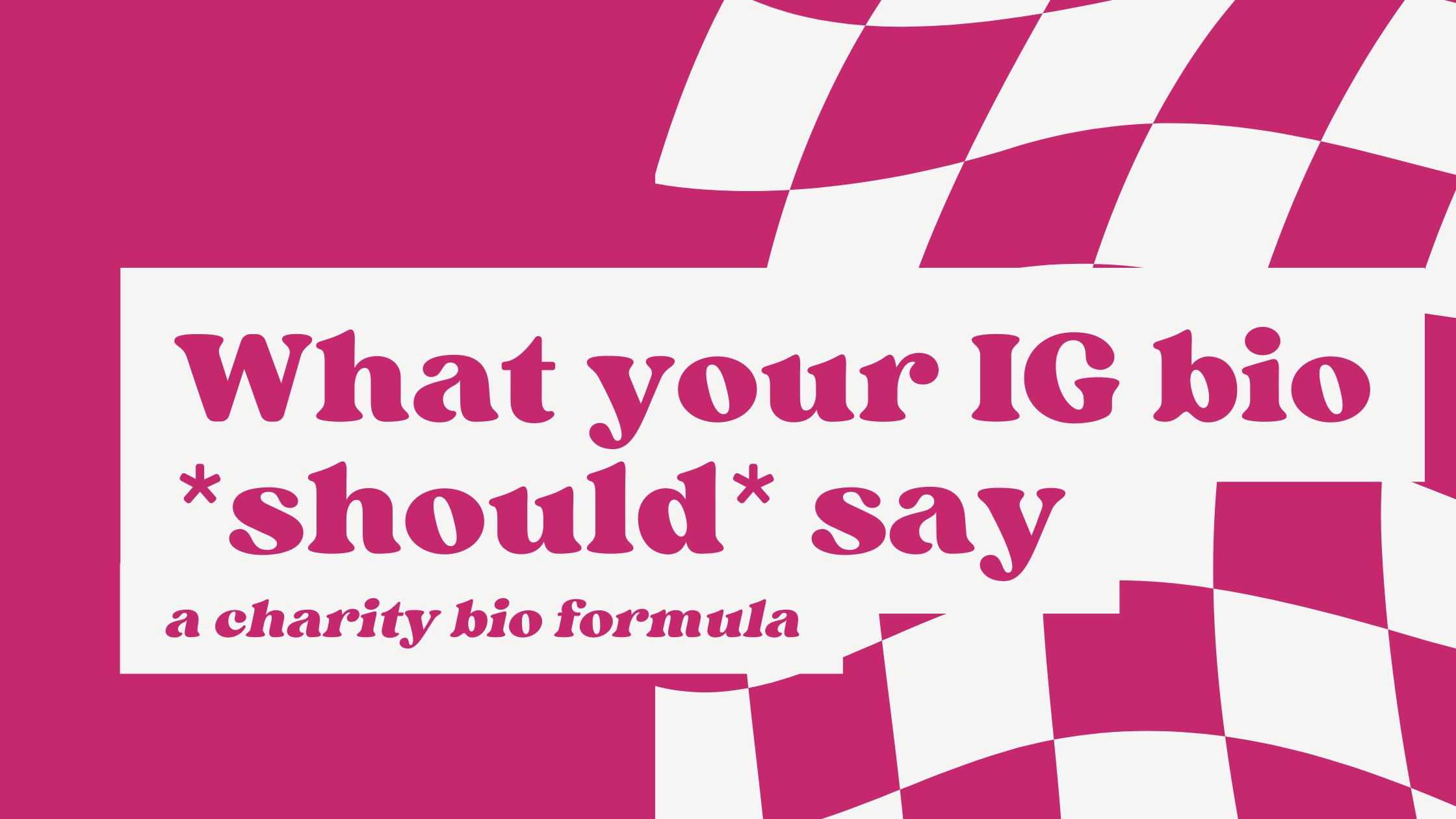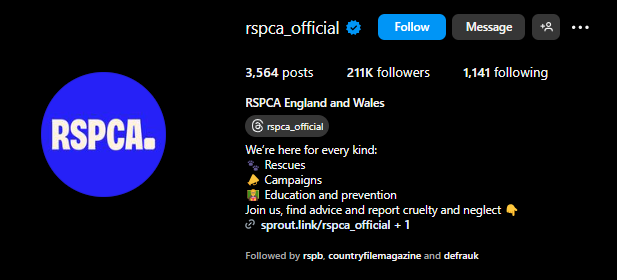Here’s What your charity’s Instagram Bio *Should* Say

First impressions are important. When a user clicks on your Instagram profile for the first time its over to you to ensure their first impression of your organisation is a good one.
One of the first things they’ll see?
Your bio.
It pains me to see the number of charities (and other businesses for that matter) who simply throw in the name of their organisation, copy and paste their mission statement and call it a day. If that’s you, don’t worry. We all start somewhere and you’ve come to the right place. In this blog we are going to cover the ins and outs of an Instagram bio that drives action.
So first things first - what’s wrong with simply adding your organisation’s name and mission statement?
Well, that’s a great question.
Firstly, the name of your organisation will appear above the bio already. This name will be the profile name you entered when you set up the page. You can change this at any time by clicking the ‘Edit Profile’ button below your bio. Adding the name of your organisation again in the bio takes up precious character space.
As for your mission statement? Chances are, the mission statement of your organisation focuses on the mission of your organisation (duh). In other words - it’s focused inwards. As we’re about to learn, this isn’t what we want when it comes to an effective Instagram bio (or any compelling copy for that matter, but that’s another blog for another time).
4 Things your Instagram Bio should be
So now we’ve covered a few things your organisation’s Instagram bio shouldn’t be, let’s talk about what a charity’s Instagram bio should be.
-
Short + Snappy.
You only have 150 characters to say what you need to say. Avoid taking up space with information the user can get elsewhere such as the the name of the organisation and contact details. Get to the point of what it is you want to tell them. -
Focused on the user NOT the organisation.
Never forget - the most compelling copy puts the user at the centre. Not the organisation, and not even the beneficiaries of your charitable organisation (unless they are the intended audience of your copy, in that case - its ALL about them). Avoid starting your bio (or any copy) with ‘At [charity name] we...’ or ‘[Charity name] aims to’. Address your ideal audience directly, to make them pay attention and take action. -
Highlight what makes your organisation unique.
Users come across a LOT of information on social media. If the user is particularly passionate about your cause, then chances are they’ve also come across other charities that might have similar aims to yours. What is your USP (unique selling point)? This is something most businesses are able to answer in a heartbeat - but charities? Not so much. Spend time on this. Don’t move on from this section until you’ve clearly identified what sets your organisation apart from other charities and non-profits in your sector. -
Focused on the problem, NOT your services
In the same way it's not about your organisation, it's also not about what you do, it's about the problem you solve. Eg. Cancer Research doesn’t just carry out cancer research - they save lives through research and education. This speaks to the user on a deeper level. You can communicate the practical side of what solving the problem looks like (what you do) through the content on your grid.
My Instagram Bio Formula
Okay so, that can all feel like a lot to remember for a simple 150 space on a social media account. But don’t fret, luckily for you I’ve put it all together into a handy formula that you can apply to your own organisation.
The formal is simply:
[A question that speaks to the user’s pain point] + [offer your organisation as the solution with a strong CTA]
The user’s pain point: Targeting potential donors or volunteers? They want feel like they are making a difference. Specifically, they want to make a difference in the lives of the people you work with or to the state of the environment or in politics or whatever area you serve. How does the user feel about the issue you are trying to solve? (hint: it’s probably quite similar to how you feel as an organisation) Phrasing this pain point as a question has bigger impact and grabs attention.
Your organisation as the solution: As I’ve already mentioned - focus on the problem you solve and not the practical things you do when crafting your charity’s bio. Take this one step further and position your organisation as the solution to the pain point of your target audience. This is also the perfect time to lean into that USP we talked about earlier.
Strong CTA (call to action): What do you want the user to do next?
- Discover a community where you belong
- Donate or volunteer today
- Get involved
- Be a part of something bigger
- Follow us to find out more
You might not get the perfect CTA right away. Change the call to action in your bio every so often and observe if there is a change in the rate of users taking the action you are calling them to.
Important: Notice when using this formula you need to be clear on your audience. ‘We want to target everyone’ isn’t a strategy on social media, or any digital marketing platform. Chose who you are speaking to and commit to it. This will make everything else a lot easier in the long run.
Some examples of how I would rewrite Instagram bios for some well known charities
RSPCA
The recent rebranding of the RSPCA leans into the idea that the RSPCA exists ‘for every kind’ of animal. I’ve used this as their USP in the updated caption below.
Does it break your heart to see animals suffering?
Join the fight and protect every kind.
Follow RSPCA for advice or click below to report cruelty and neglect
OR
Do you believe in a better world for every kind of animal?
Donate today and help change lives, laws and minds so animals can live a better life.
Notice the bio is different in each to reflect a different CTA
Alzheimer’s Society
One thing I noticed when researching the Alzheimer’s Society was that a lot of people engaging with their social media profile’s were people caring for those with an Alzheimer's diagnosis and seeking support and guidance. Therefore they might chose to tailor their account towards the beneficiaries as opposed to supporters. This is the perfect example where you might start out with one strategy for one particular audience in mind for your organisation but then pivot based on the data.
Dealing with a loved one’s dementia diagnosis?
You don’t have to go through it alone.
Follow Alzheimer's Society for help and hope
Or, if the strategy behind their Instagram is to increase support their bio might read like this:
Do you believe in a dementia free world?
Help transform the future for everyone living with dementia.
Become a supporter today
In this example, the two different bios reflect two different target audience. This brings me back to the point that targeting anyone and everyone is not an effective strategy - you need to get specific
A note on hashtags and emojis.
As we round up this blog I’m going to touch on two things I get asked about a lot - emojis and hashtags. First up, the emoji.
Should you use emojis in a bio? In my opinion I think it’s completely up to you! A few things to consider:
- If you’re going to use them - use them sparingly. I wouldn’t use more than two in your bio
- Consider their relevance. Opt for an emoji that feels relevant to your organisation. For example the Woodland Trust (@woodlandtrust) use the tree emoji. If your charity has one or two distinctive colours you might opt for the coloured heart emojis.
- Consider the limited space. With only 150 characters to play with - do you really need 5 different ocean emojis for you sea life protection charity? Would it not be better to use your limited characters inspire potential supporters to action?
- Does using emoji’s match the tone of voice you want to convey as an organisation? Instagram and other social media platforms are an opportunity to show a lighter, more authentic side of the organisation, but if emojis feel misaligned for your organisation, don’t force it.
As for hashtags… it depends. Using a generic hashtag that isn’t specific to your organisation (eg. #love) is not recommended. However, creating a hashtag that is unique to your organisation such as the NSPCC’s #EveryChildhood can be a great tool for engagement, reach and raising the awareness of your charity. If there is a particular brand hashtag you would like people to use when they are talking about the issue you represent, including it in your bio is the best way to ensure users are aware of it.
Hopefully this short blog has left you with a clear step by step on crafting an effective Instagram bio for your charity. If you haven’t already, be sure to sign up to my mailing list so you can get more content just like this straight to your inbox.
PS: I love receiving emails even more than I love sending them - if you have any questions about what I’ve covered in this blog you can fire me an email at rebecca@untangledmarketing.co.uk


